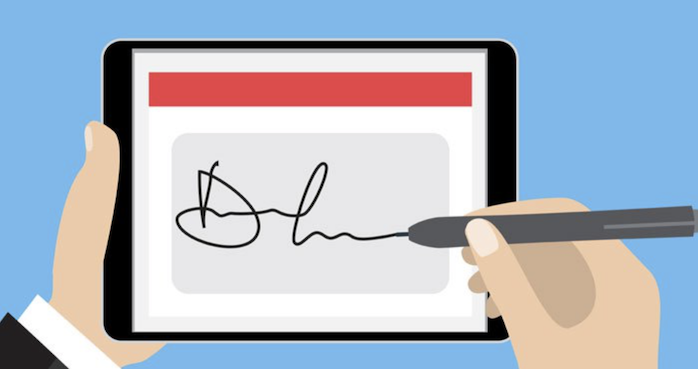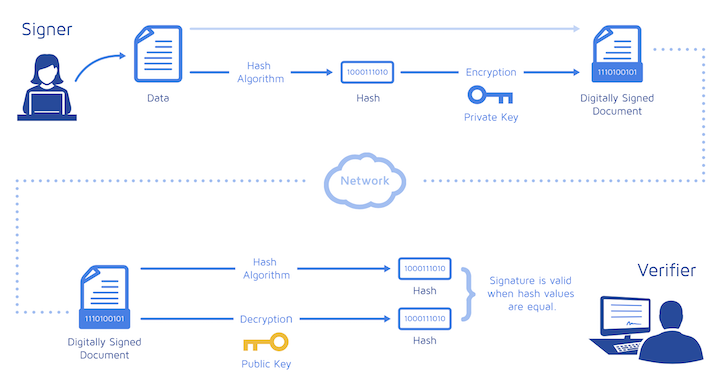It has become a trend nowadays, or we can say, necessary, to use an electronic signature or digital signature. It reduces paperwork and is a more convenient way to manage your documents.
E-signatures, or electronic signatures, allow us to digitally sign legally binding contracts without needing physical paper or pen and ink. Because they may be used to sign papers remotely, regardless of the recipient’s location, they are more convenient than a conventional signature, saving time and postal costs. As a result, it’s not hard to understand why electronic signatures are quickly becoming an industry standard for many SMBs.
Digital signatures are a special kind of electronic signature that verifies the signer’s identity and the document’s authenticity via the use of complicated algorithms, certificates, and third-party verification services.
Here in this tutorial, we are going to cover the following points.

- What is an electronic signature?
- How Does Electronic Sign Work?
- Best E-signing software.
You can easily create the signature on PC and using Smartphones.
1. What is an Electronic Signature?
E-Sign is an electronic expression on the documents of agreements and contracts to make them authorized and legal. You can add a signature without a printout, scanning, or faxing option.
An e-sign is the signature you draw on the document using a mouse cursor (handwritten sign) or the default signature per your name.
Is an electronic sign legal?
Yes, it is legal to have an e-signature on your document, widely used on contracts, invoices, agreements, and much more. The widely accepted e-signature is in the US, UK, Canada, EU, and many other countries.
2. How Do Electronic Signs Work?
The process of the verified digital signature is a bit complex; let us try to understand it more easily. There is a much-advanced software that provides secure and verified digital signatures. Here we are considering DocuSign as how this works.
Consider that you have created a signature that is unique for every user. There is a protocol that DocuSign follows in the process of verifying the signature. Once you create a signature, the private key is assigned to the user, and then your data is encrypted, which we call a digital signature.

There are two keys while creating a signature. One is the private key, and the other is the public key. Suppose you have sent some agreement to others and that along with that agreement, the receiver also got your private key. If the public key can’t decrypt the signature, that means the signature is invalid. So you are entirely on the safe side.
3. Best Electronic Signature Software
Well, there are different categories for electronic signatures, and you must be careful when choosing the best one. You might be interested in productivity software that includes an e-sign option or just looking only for e-sign software.
1. Nitro Productivity Suite: Nitro Pro is one of the best and recommended software to make your paperwork easier. It has many advanced features and options besides just adding a signature to your document. You can create, edit, and sign a document in every format. This also offers Nitro Cloud service to store your documents online, which is one of the secure ways to keep your document. Check: Nitro Pro Review
2. DocuSign: DocuSign is a well-known name for verifying your document’s digital signature. This uses a specific protocol to make your sign completely secure. It also offers cloud storage to keep your documents safe and secure. There are different plans as per your requirements.
3. HelloSign: If you’re looking for a bit cheaper option having all the same advantages, HelloSign is considered one of the best solutions. It also has all the primary tools required for a digital signature. HelloSign comes in Pro, Business, and Enterprise levels. You can also enjoy a 30-day free trial period.
Digital Signatures vs. Electronic Signatures and Their Nuances
Anyone who has to email or sign a document will likely not notice a significant difference between electronic and digital signatures. However, auditors, compliance officials, courts, and regulators see right through them. Electronic signatures, often known as “e signatures” or “e-signatures,” may be handwritten in digital form or created via a third-party service like DocuSign. Electronic signatures are becoming more common, and digital signatures are one kind that is both legally binding and cryptographically secure.
In cases when security and compliance requirements are loose, ordinary e-signatures may be appropriate for agreements and approvals. Consider the HR department’s role in approving employees’ requests for time off. In some instances, electronic signatures provide the ideal solution.
However, a digital signature is necessary when working with procedures that must adhere to stringent security and compliance regulations. To put it simply, digital signatures are an electronic signature subset with enhanced security and other qualities that make them particularly well suited to the needs of the legal and medical fields. Digital signatures are equipped with encryption, audit trails, and other mechanisms to guarantee the signature’s authenticity. These are often used for legal and financial documents, including contracts, tax returns, insurance applications, and other similar forms.
On our recommendation, if you have more digital paperwork, you must try Nitro Productivity Suite as they offer a 30% discount to our readers (discount link).
I hope you like this tutorial about What is an Electronic Signature? and easily understand how it works and the best software in this category. For the latest tech tutorials, software deals, and reviews, follow madestuffeasy.com on Facebook and Twitter.
Subscribe to the newsletter for regular updates.
Related Articles: